

William Faulkner. Pylon // The Tarnished Angels.
Showman's Manual.[N.p.]:
Universal International, 1957.
While most critics consider Pylon to be Faulkner's most flawed novel ("unnecessary horror and violence," "unintelligible descriptive passages," an "inconceivable climax"), Faulkner himself is reported to have considered "The Tarnished Angels" (1957) the best screen adaptation of his work. This may have been because director Douglas Sirk was interested in making a movie emphasizing returning World War II soldiers who were completely at a loss, drifting rootlessly without a home, without genealogy. Scholar Michael Stern says that Sirk saw the characters in Pylon as wandering on the outside of life "in their futile circling of the [racing] pylons." In addition, the "aesthetic desperation of the prose itself" gave Sirk the basis on which to create a film about postwar despair. The screenplay written by George Zuckerman, combined with Sirk's vision, produced a movie that Faulkner felt was better than the original novel.
This "Showman's Manual" offers posters and press releases that can be used in promoting the film.
William Faulkner. Pylon. New York: New American Library, 1951.
These paperback editions display Signet's consistent interest in scantily-clothed women and rough-living men, with their 1958 cover changed to appeal to readers who had seen the recently-released movie. The 1987 Vintage Books publication used a drawing by David Tamura that highlights the hope and the tragedy that these new machines represent.

